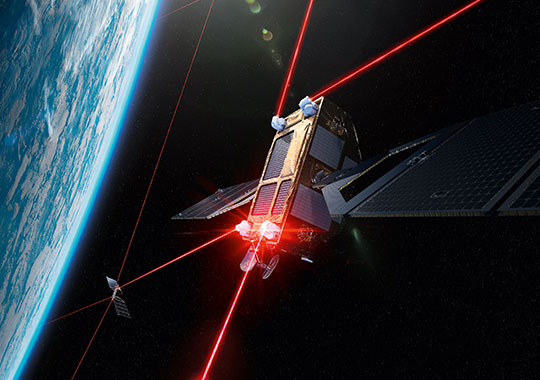 Bulent Altan, CEO of Mynaric, talked laser terminal technology with Constellations.
Bulent Altan, CEO of Mynaric, talked laser terminal technology with Constellations.
Constellations recently spoke with Mynaric CEO Bulent Altan about how satellite communications are being impacted by the introduction of laser terminals space. Radio frequency (RF)-based communications have been the staple for transmitting data in space, but the movement from analog to digital signals has opened the door for new methods of data transmission.
While RF may be here to stay for wide area coverage situations, optical communication lasers have emerged into the market for high bandwidth, high security point-to-point communications. Bulent explored why laser terminal technology is one of the more prominent disruptors and how its implementation will impact the future of space communications.
The Landscape of Global Network Communication
“Since the dawn of wireless communications, RF-based communications have been the dominant, if not the only major way, of communicating reasonable amounts of data. These RF-based communications have given us everything from radio, early broadcast TV, aviation and maritime communication, communication for our civil, military, and government needs, and more,” said Altan.
RF communications in space have largely been analog in nature at first, the advent of digital technologies brought about capabilities such as Wi-Fi and cell networks. Digitized RF signals are well suited for applications requiring wide area and wide geographical coverage situations.
He added that, while digitized RF signals are here to stay for those applications “not all communication needs to be a sender and a whole group of receivers scattered over a large area. Just like in wired and wireless communication, we have cases where we need to communicate between two points with very high bandwidth, high security, low power and mass, and immunity towards jamming through adversary means.”
This is where free space optical communication technology can fit in to strengthen and grow space networks.
What Makes Optical Different?
Laser terminals work by utilizing an accurately steered infrared laser beam to transmit data unguided through air.
“What we understand about a laser terminal - or more accurately named free space optical communications terminal - is that it's a device which simultaneously transmits and receives a laser beam over long distances while using an outgoing laser beam to communicate vast amounts of data to the communication partner,” explained Altan, “You can complete tens of gigabits per second of communication that way.”
With more advanced modulation techniques, you can move even more data. Hundreds of gigabits of can be transmitted from two satellites to airplanes, from a satellite to a ground station, from satellite to satellite as an inter-satellite link and to other communication nodes.
 Laser inter-satellite links can make the high-speed connections between the numerous satellites that make up space constellations. Source: Mynaric
Laser inter-satellite links can make the high-speed connections between the numerous satellites that make up space constellations. Source: Mynaric
Laser terminals must be resistant to communication disruptions by satellite movement and even the tiniest of vibrations. “This means that both terminals need to track each other accurately, with multiple orders of magnitude, and keep the beam concentrated by staying on top of one another.” These highly accurate optics, internal to the terminal, must maintain accuracy over vast temperature ranges and quick moving mirrors.
At the heart of free space optical communication technology, rests a unique and advanced software system that controls operations multiple hundreds of times per second.
Integration is generally not difficult because laser terminals, such as those built by Mynaric, appear to a satellite as simply a cable connecting it to other satellites.
“That means any kind of data can be transmitted over the multiple thousands of kilometers of our terminals. In our CONDOR Mk3 case, that's up to 8,000 kilometers, and in our larger case, the CONDOR MEO terminal, it's up to 40,000 kilometers in distance. Those hundreds of gigabits and underlying data can be anything,” explained Altan.
Strengths and Weaknesses of Laser Terminals
When asked about the pros and cons of using laser terminals in space, Altan stated that optical communication is a complementary technology to a pre-existing one and, as such, it isn't here to completely replace radio-based communication. Laser terminals can enable new use cases or can bridge the gap in certain use cases where RF is falling short.
Low power usage, low sensitivity to vibration, a high security character, and reliable connectivity between fast moving objects are the main advantages of optical communication.
Because laser terminal beams are not omnidirectional, the physical beam does not go anywhere other than the communication partner. “So, it can't be hacked, it can't be interfered with, and it is also impossible to jam. In today's world, we see radio-based communications being jammed quite frequently by adversarial forces.”
Traditional RF intersatellite links transmit 6 to 8 megabits per second while laser terminals of the same power and mass, can get 100 gigabits per second – which is a tremendous difference in throughput.
There are instances in which optical communications are not a perfect fit, however. For example, clouds can interfere with laser data transmission through the atmosphere, the same way they interfere with light transmission.
 Optical ground stations for space receive laser communication signals from Earth observation missions or satellite constellations. Source: Mynaric
Optical ground stations for space receive laser communication signals from Earth observation missions or satellite constellations. Source: Mynaric
In addition, optical communication implementations are limited to point-to-point operation today and multi-point communication technologies for optical content preparation is still many years out. “To cover a wide area, you would need to use RF signals,” Altan added.
“For example, a communications constellation satellite would need a connection that would ground thousands of users. Like a single Starlink satellite, that would be done in radio frequency. But, for that same satellite’s point-to-point communication to a neighboring satellite, gateway, or ground station, that would use optical communication, concentrating the thousands of pieces of communication from multiple users into a single laser beam and handing it up.”
Ideal Applications for Laser Communication
When asked where laser terminals would be ideally incorporated, Altan said, “The immediate application that comes to everyone's mind is broadband constellations. These constellations may include thousands and even tens of thousands of satellites getting broadband connectivity into every single nook and cranny of this earth.”
These constellations support mobility applications in providing broadband internet to airplanes, ships, and less densely populated areas. “When you are doing an internet-of-things out in the North Sea, or maybe doing wind farms, you need connectivity everywhere, and you need it in a broadband fashion,” added Altan.
“By having a mesh network, a satellite that does not have a ground station in view can take the data it gathered from its earth observation sensor and hand it over to a neighboring satellite. That satellite can then hand it over to its neighboring satellite until the data arrives at a satellite that a ground station is able to view and downlink at,” said Altan, “I think this will bring yet another revolution in earth observation.”
The Impact of Laser Terminal Adoption on Global Space Networks
Laser terminals are acting as the enabling technology behind these massive global broadband constellations.
“The economy has been very digitally driven, and people in large cities that are well connected have an advantage in being in the workforce. We've seen this more so in the COVID crisis over the last two years, we went away from the offices and are all at our homes doing remote work. There we've seen the capability differences that exist between people. If you can solve the digital divide that exists between people who have access to broadband and people who don't, you will ensure that there is an equality between different geographies and that anyone can be a part of the global digital economy,” Altan concluded.
Click here to listen to the full Constellations podcast interview.
